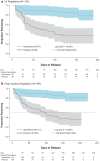A Randomized Trial of Iloperidone for Prevention of Relapse in Schizophrenia: The REPRIEVE Study
- PMID: 27379654
- PMCID: PMC4982888
- DOI: 10.1007/s40263-016-0345-4
A Randomized Trial of Iloperidone for Prevention of Relapse in Schizophrenia: The REPRIEVE Study
Abstract
Background: The purpose of this study was to evaluate the safety and effectiveness of iloperidone for the prevention of relapse in schizophrenia.
Methods: Study subjects were adults with schizophrenia who started on oral open-label iloperidone titrated to an initial target dose of 12 mg/day (6 mg twice daily) and then stabilized on a flexible-dose iloperidone regimen (range 8-24 mg/day) for up to 24 weeks. Subjects meeting stabilization criteria then entered the relapse-prevention phase and were randomized 1:1 in a double-blind fashion to continue with iloperidone or placebo withdrawal for up to 26 weeks or until meeting relapse or other withdrawal criteria.
Results: A total of 303 subjects were randomized to the relapse-prevention phase; 153 continued to receive iloperidone, and 150 were withdrawn to placebo. The modal total daily dose for iloperidone in all phases of the study was 12 mg/day. The pre-defined unblinded interim analysis upon reaching 68 relapse events confirmed the hypothesis that iloperidone (n = 97) was more effective than placebo (n = 96) in preventing relapse events, and the trial was stopped early. The estimated relapse rates were 63.4 % (Kaplan-Meier [KM] estimate) for placebo compared with 20.4 % (KM estimate) for those continuing to receive iloperidone (log rank test: p < 0.0001). The mean time to relapse was 71 days for placebo and 139 days for iloperidone (hazard ratio 4.7; 95 % confidence interval 2.7-8.3; p < 0.0001). The safety profile observed in previous short-term studies was also reaffirmed in this maintenance treatment setting. The most common treatment-emergent adverse events (TEAEs) in the stabilization phase were dizziness (11.6 %), somnolence (8.3 %), and dry mouth (6.8 %). Rates of reported extrapyramidal disorder or akathisia during stabilization were 2.5 and 3.7 %, respectively.
Conclusions: Flexible dosing of iloperidone for maintenance-phase therapy, with a modal dose of 12 mg/day was effective in preventing relapse in subjects previously stabilized on iloperidone. The adverse event profile for iloperidone was consistent with other studies, and the low extrapyramidal symptom and akathisia burden during stabilization was sustained during the course of the study. ClinicalTrials.gov identifier: NCT01291511.
Figures



References
-
- Fanapt (iloperidone) [prescribing information]. Washington, DC: Vanda Pharmaceuticals Inc.; 2014.
Publication types
MeSH terms
Substances
Associated data
LinkOut - more resources
Full Text Sources
Other Literature Sources
Medical

